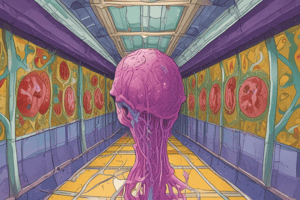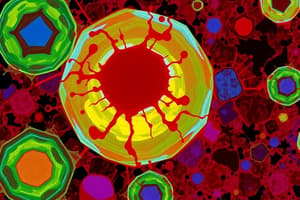Podcast
Questions and Answers
What role does MPO deficiency play in infection susceptibility?
What role does MPO deficiency play in infection susceptibility?
MPO deficiency increases the risk of Candida infections.
How do neutrophils differ from macrophages in terms of lifespan during inflammation?
How do neutrophils differ from macrophages in terms of lifespan during inflammation?
Neutrophils undergo apoptosis within 24 hours, while macrophages peak at 2-3 days and continue to play a role in inflammation.
What are the two main signals required for T cell activation?
What are the two main signals required for T cell activation?
T cell activation requires the binding of the antigen/MHC complex and an additional second signal, often provided by a costimulatory interaction.
What is the defining feature of granulomatous inflammation?
What is the defining feature of granulomatous inflammation?
Which cytokines are mainly secreted by Th1 cells and what are their functions?
Which cytokines are mainly secreted by Th1 cells and what are their functions?
How does the process of B cell activation depend on T cells?
How does the process of B cell activation depend on T cells?
Explain the importance of the NADPH oxidase in bacterial killing.
Explain the importance of the NADPH oxidase in bacterial killing.
What characterizes the difference between MHC I and MHC II in relation to T cell subsets?
What characterizes the difference between MHC I and MHC II in relation to T cell subsets?
What is the primary function of negative selection in the thymus?
What is the primary function of negative selection in the thymus?
How does the cytotoxic CD8+ T cell pathway induce cell death?
How does the cytotoxic CD8+ T cell pathway induce cell death?
Which reactive oxygen species is considered the most damaging and why?
Which reactive oxygen species is considered the most damaging and why?
What is a common consequence of carbon tetrachloride (CCl4) exposure in the liver?
What is a common consequence of carbon tetrachloride (CCl4) exposure in the liver?
What are the main components of acute inflammation?
What are the main components of acute inflammation?
What triggers fever during acute inflammation?
What triggers fever during acute inflammation?
What role do Toll-like receptors (TLRs) play in the immune response?
What role do Toll-like receptors (TLRs) play in the immune response?
Describe the appearance of amyloid deposits in tissue.
Describe the appearance of amyloid deposits in tissue.
What are the two main types of systemic amyloidosis and their causes?
What are the two main types of systemic amyloidosis and their causes?
What clinical condition is most commonly associated with kidney involvement in amyloidosis?
What clinical condition is most commonly associated with kidney involvement in amyloidosis?
What distinguishes noncaseating granulomas from caseating granulomas?
What distinguishes noncaseating granulomas from caseating granulomas?
Describe the role of CD4 T cells in granuloma formation.
Describe the role of CD4 T cells in granuloma formation.
What is DiGeorge Syndrome and its genetic basis?
What is DiGeorge Syndrome and its genetic basis?
What is the main defect in X-linked agammaglobulinemia?
What is the main defect in X-linked agammaglobulinemia?
Explain the concept of central tolerance in the bone marrow.
Explain the concept of central tolerance in the bone marrow.
What are the two main causes of hyper-IgM syndrome?
What are the two main causes of hyper-IgM syndrome?
What is the significance of regulatory T cells in immune tolerance?
What is the significance of regulatory T cells in immune tolerance?
How does zinc deficiency affect wound healing?
How does zinc deficiency affect wound healing?
What is apoptosis, and how is it regulated at the molecular level?
What is apoptosis, and how is it regulated at the molecular level?
Describe how cancer cells invade surrounding tissues.
Describe how cancer cells invade surrounding tissues.
What is the relationship between immunodeficiency and cancer risk?
What is the relationship between immunodeficiency and cancer risk?
What role does IFN-gamma play in macrophage activation?
What role does IFN-gamma play in macrophage activation?
Which cytokines are produced by regulatory T cells and what is their function?
Which cytokines are produced by regulatory T cells and what is their function?
Flashcards
Cytotoxic CD8+ T cell pathway
Cytotoxic CD8+ T cell pathway
A process where cytotoxic CD8+ T cells eliminate infected or cancerous cells. It involves perforins creating pores in the target cell membrane, allowing granzyme to enter and activate caspases, leading to apoptosis.
Apoptosis
Apoptosis
A type of cell death characterized by a series of biochemical events leading to a controlled dismantling of the cell. It is crucial for the removal of damaged or unwanted cells.
Hydroxyl radical (OH)
Hydroxyl radical (OH)
A highly reactive molecule that is a major contributor to oxidative stress and damage. It is generated during normal cellular processes and can also be produced by environmental factors.
Superoxide burst
Superoxide burst
Signup and view all the flashcards
Amyloidosis
Amyloidosis
Signup and view all the flashcards
Primary amyloidosis (AL)
Primary amyloidosis (AL)
Signup and view all the flashcards
Secondary amyloidosis (AA)
Secondary amyloidosis (AA)
Signup and view all the flashcards
Acute inflammation
Acute inflammation
Signup and view all the flashcards
Toll-like receptors (TLRs)
Toll-like receptors (TLRs)
Signup and view all the flashcards
NF-κB pathway
NF-κB pathway
Signup and view all the flashcards
Neutrophils
Neutrophils
Signup and view all the flashcards
Macrophages
Macrophages
Signup and view all the flashcards
Granulomatous inflammation
Granulomatous inflammation
Signup and view all the flashcards
Myeloperoxidase (MPO)
Myeloperoxidase (MPO)
Signup and view all the flashcards
CD4+ T helper cells
CD4+ T helper cells
Signup and view all the flashcards
CD8+ cytotoxic T cells
CD8+ cytotoxic T cells
Signup and view all the flashcards
B lymphocytes
B lymphocytes
Signup and view all the flashcards
Resolution of inflammation
Resolution of inflammation
Signup and view all the flashcards
Noncaseating granulomas
Noncaseating granulomas
Signup and view all the flashcards
Caseating granulomas
Caseating granulomas
Signup and view all the flashcards
DiGeorge Syndrome
DiGeorge Syndrome
Signup and view all the flashcards
SCID (Severe Combined Immunodeficiency)
SCID (Severe Combined Immunodeficiency)
Signup and view all the flashcards
X-linked agammaglobulinemia
X-linked agammaglobulinemia
Signup and view all the flashcards
Common Variable Immunodeficiency (CVID)
Common Variable Immunodeficiency (CVID)
Signup and view all the flashcards
IgA deficiency
IgA deficiency
Signup and view all the flashcards
Hyper-IgM Syndrome
Hyper-IgM Syndrome
Signup and view all the flashcards
Wiskott-Aldrich Syndrome
Wiskott-Aldrich Syndrome
Signup and view all the flashcards
Complement Deficiency
Complement Deficiency
Signup and view all the flashcards
Tolerance
Tolerance
Signup and view all the flashcards
Central Tolerance
Central Tolerance
Signup and view all the flashcards
Peripheral Tolerance
Peripheral Tolerance
Signup and view all the flashcards
Regulatory T cells
Regulatory T cells
Signup and view all the flashcards
Wound Healing
Wound Healing
Signup and view all the flashcards
Regenerative Capacity of Tissues
Regenerative Capacity of Tissues
Signup and view all the flashcards
Labile Tissues
Labile Tissues
Signup and view all the flashcards
Stable Tissues
Stable Tissues
Signup and view all the flashcards
Permanent Tissues
Permanent Tissues
Signup and view all the flashcards
Granulation Tissue
Granulation Tissue
Signup and view all the flashcards
Scar Formation
Scar Formation
Signup and view all the flashcards
Delayed Wound Healing
Delayed Wound Healing
Signup and view all the flashcards
Neoplasia
Neoplasia
Signup and view all the flashcards
Protooncogenes
Protooncogenes
Signup and view all the flashcards
Tumor Suppressor Genes
Tumor Suppressor Genes
Signup and view all the flashcards
Metastasis
Metastasis
Signup and view all the flashcards
Invasion
Invasion
Signup and view all the flashcards
Angiogenesis
Angiogenesis
Signup and view all the flashcards
Immune Surveillance
Immune Surveillance
Signup and view all the flashcards
Study Notes
Growth Adaptations, Cell Death, and Injury
- Atrophy is a decrease in cell size or number (apoptosis). It occurs through ubiquitin-proteosome degradation of the cytoskeleton and autophagy of cellular components.
- Autophagy is a cellular process where vacuoles are formed to contain cellular components and then consumed by lysosomes.
- Metaplasia is a reversible reprogramming of stem cells. It can occur with removal of the stressor that caused it, but can progress to cancer. An example of an exception is apocrine metaplasia, which is not linked to cancer. Vit A deficiency can cause metaplasia of specialized epithelia, such as the conjunctiva of the eye. Keratomalasia and myositis ossificans are associated with thickened conjunctiva and inflammation of skeletal muscle (converting to bone), respectively.
- Dysplasia is a reversible condition unlike cancer, often caused by inflammation of skeletal muscle (trauma). An example is cervical intraepithelial neoplasia (CIN).
- Aplasia is failure of cellular production during embryogenesis, an example is unilateral renal agenesis.
- Hypoplasia is a decrease in cell production during embryogenesis, one example given is a streak ovary in Turner syndrome.
Cell Injury
- Hypoxia is a decrease in blood flow through an organ (ischemia). This can be due to blockage in arteries or veins, or shock.
Cell Death
- Necrosis is the death of a large group of cells, resulting in acute inflammation. Types of necrosis include coagulative necrosis, and liquefactive necrosis, where cell shape/architecture is retained while the tissue becomes loosely organized.
- Apoptosis is the death of individual/small groups of cells, without the inflammatory response associated with necrosis. This process involves shrinkage of cells, which is followed by the removal of cellular components by macrophages.
Other
- Example of oxygen carrying capacity decrease includes anemia, since normal oxygen levels may be bound by a dysfunctional hemoglobin (Hb).
Studying That Suits You
Use AI to generate personalized quizzes and flashcards to suit your learning preferences.




